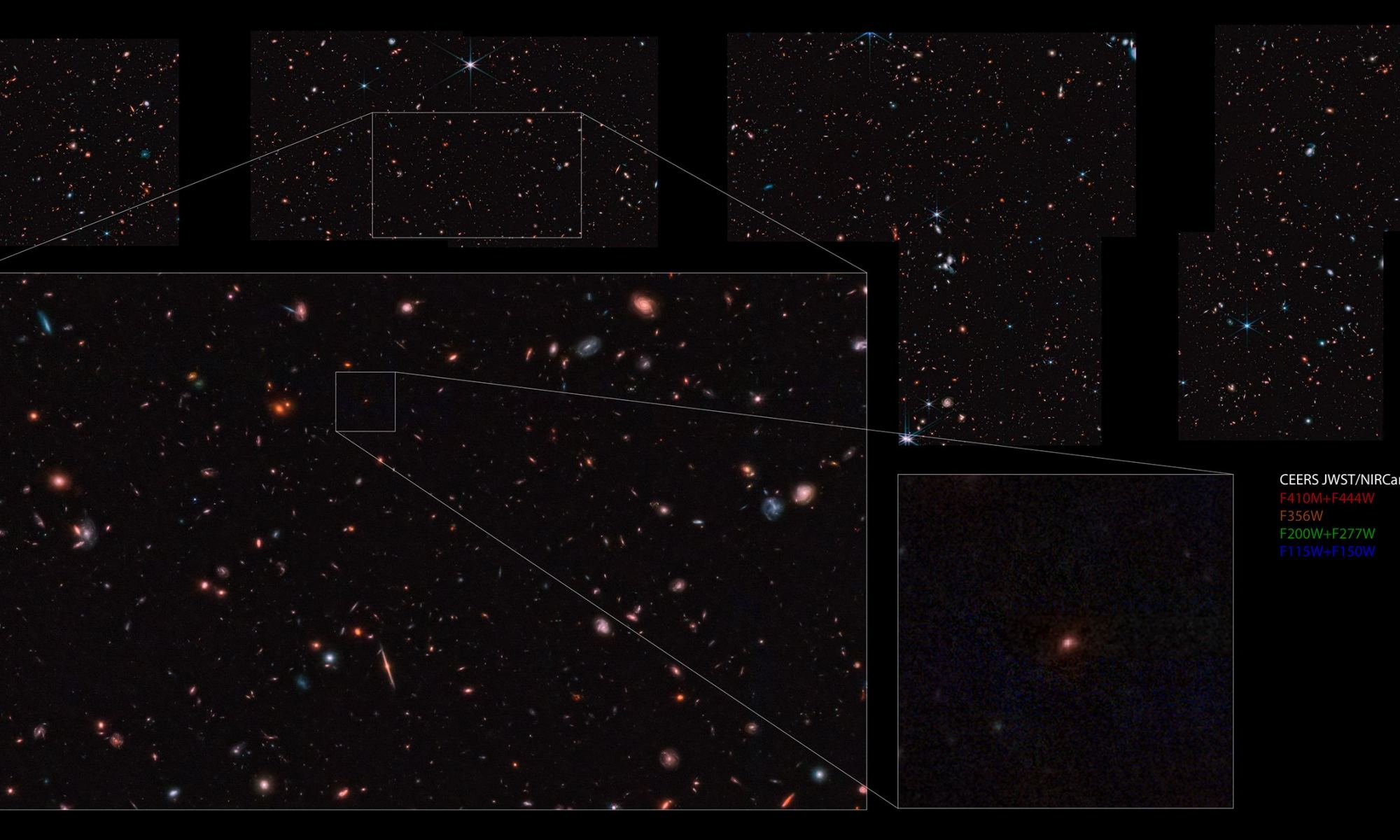The very early Universe was a busy place, particularly when stars and galaxies began to form. Astronomers eagerly search for the farthest galaxy—that elusive “first” one to form. JWST is part of that hunt through its Cosmic Evolution Early Release Survey (CEERS).
Recently, scientists announced a tentative candidate for the “farthest galaxy” award. Astronomers nicknamed it “Maisie’s Galaxy” and it looked like it might be smack in the middle of that early epoch of cosmic history. Then, another one was announced even earlier in time, at a redshift of z~16. That would put it at nearly 13.8 billion light-years away, which seems pretty fantastic. Those were exciting finds. But, they needed to be confirmed.
Chasing the Elusive “Farthest Galaxy”
Ever since the Hubble Space Telescope began finding galaxies at large cosmic distances, it’s been a race to find one at the earliest epoch possible. Doing it with optical observations is not possible. So, the best way to determine the distance (and age) of all the “earliest galaxy” candidates is to do spectroscopy.
That’s what a team led by astronomer Pablo Arrabal Haro (National Optical-Infrared Astronomy Research Laboratory in Tucson, AZ) did. They combined work with a team in Scotland and studied the redshift of several galaxies, including Maisie’s Galaxy. Their paper outlining the work came out recently. It confirms that Maisie’s Galaxy existed at least 390 million years after the Big Bang. The study also shows that the farthest galaxy, called CEERS-93316, isn’t quite as far away as everybody thought. Early observations suggested it existed at least 250 million years after the Big Bang.
Arrabal’s team’s work disproved CEERS-93316’s distance but confirmed Maisie’s Galaxy’s place in the early Universe. It also gives insight into conditions early in cosmic history. “What distinguishes Maisie’s Galaxy and CEERS2_588 from the few other confirmed galaxies at that epoch of the Universe is that they are more luminous,” said Arrabal Haro. “Confirming two ultra-distant, very luminous galaxies reinforces the idea of a fast growth of galaxies in the first few hundred million years after the Big Bang, which is hard to explain with our current models of galaxy formation.”
Determining the Distance to the Farthest Galaxy
To get these accurate distances, the research team performed follow-up spectral studies of these two galaxies. That let them get the most precise distance measurements possible, according to co-author Jeyhan Kartaltepe of the Rochester Institute of Technology. “Spectra are how you really confirm what a galaxy’s redshift is,” she explained. “For these two galaxies, the answer was very clear—the spectra look completely different. We confirmed that Maisie’s Galaxy is at the high redshift we thought it was.”

The same research disproved the z~16 distance for CEERS-93316. It turns out that because of a coincidence that mimicked the colors of a high redshift galaxy, it’s not at a redshift of z~16. It’s at a more realistic redshift of z~4.9—a distance of just over 12 billion light-years. That means it’s not the farthest galaxy (and thus not the earliest). But, it’s still in that period of time when the first generations of stars and galaxies were lighting up the infant Universe.
Early galaxies and their star formation episodes tell astronomers a lot about conditions in the early Universe. In the earliest epochs, the Universe was a quark soup of particles. As it expanded and cooled, it set the stage for the first galaxies to exist. They didn’t start out as star-filled objects with clouds of gas and dust. But, it appears they formed quickly, and astronomers want to know what sped their birth and evolution.
JWST Leads the Way
These JWST discoveries and measurements are a huge testament to the power of that observatory. Scientists are using it to detect the highest redshift galaxies—taking them farther back in time. This is a huge part of JWST’s science mission: to find the farthest galaxy—that is, one at nearly the dawn of cosmic time. Its observations should also reveal the conditions of the early Universe in greater detail.
“It shows us how powerful the telescope is and its ability to do the things it was built to do,” said Kartaltepe. “In some ways, it performs even better than we expected. We are already learning so much about the universe early on in JWST’s mission. I think going forward we’re going to be able to build large samples over larger areas and really be able to dig deeper into the physical characteristics of galaxies in the early universe.”
As JWST looks farther back into the infancy of the Universe, we can expect to see more announcements of early galaxies. Eventually, JWST, or a successor, will find that elusive “first galaxy”. That discovery will tell a great deal about conditions only a few hundred million years after the Big Bang occurred.
For More Information
Collaboration with Global Team Confirms, Disproves Distant Galaxies
Confirmation and Refutation of Very Luminous Galaxies in the Early Universe
Peering Back to the Early Universe: A Story of Confirmation and Refutation

